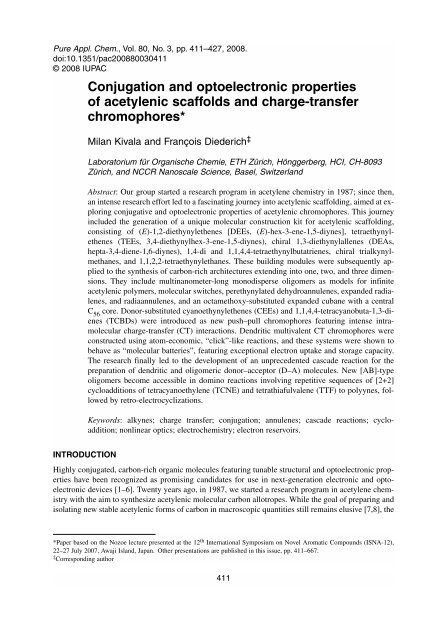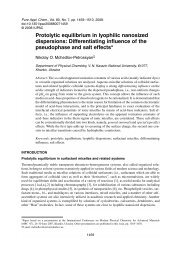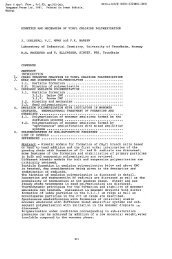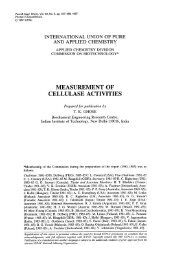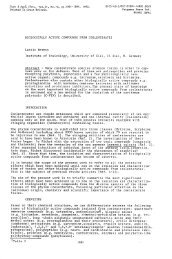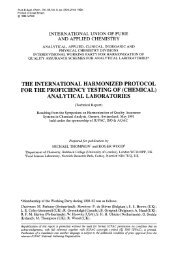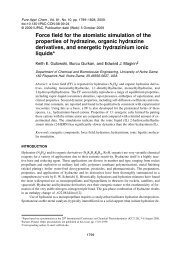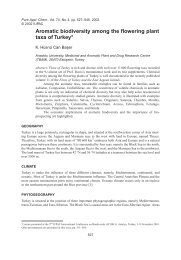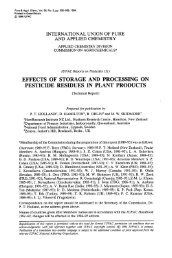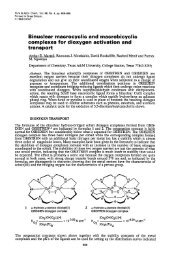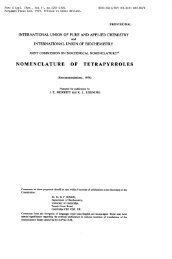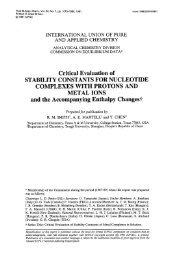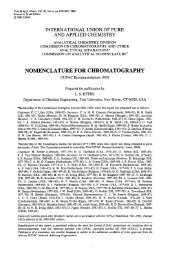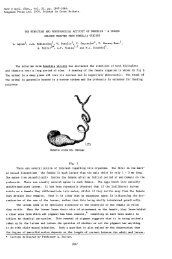Conjugation and optoelectronic properties of acetylenic ... - IUPAC
Conjugation and optoelectronic properties of acetylenic ... - IUPAC
Conjugation and optoelectronic properties of acetylenic ... - IUPAC
You also want an ePaper? Increase the reach of your titles
YUMPU automatically turns print PDFs into web optimized ePapers that Google loves.
Pure Appl. Chem., Vol. 80, No. 3, pp. 411–427, 2008.<br />
doi:10.1351/pac200880030411<br />
© 2008 <strong>IUPAC</strong><br />
INTRODUCTION<br />
<strong>Conjugation</strong> <strong>and</strong> <strong>optoelectronic</strong> <strong>properties</strong><br />
<strong>of</strong> <strong>acetylenic</strong> scaffolds <strong>and</strong> charge-transfer<br />
chromophores*<br />
Milan Kivala <strong>and</strong> François Diederich ‡<br />
Laboratorium für Organische Chemie, ETH Zürich, Hönggerberg, HCI, CH-8093<br />
Zürich, <strong>and</strong> NCCR Nanoscale Science, Basel, Switzerl<strong>and</strong><br />
Abstract: Our group started a research program in acetylene chemistry in 1987; since then,<br />
an intense research effort led to a fascinating journey into <strong>acetylenic</strong> scaffolding, aimed at exploring<br />
conjugative <strong>and</strong> <strong>optoelectronic</strong> <strong>properties</strong> <strong>of</strong> <strong>acetylenic</strong> chromophores. This journey<br />
included the generation <strong>of</strong> a unique molecular construction kit for <strong>acetylenic</strong> scaffolding,<br />
consisting <strong>of</strong> (E)-1,2-diethynylethenes [DEEs, (E)-hex-3-ene-1,5-diynes], tetraethynylethenes<br />
(TEEs, 3,4-diethynylhex-3-ene-1,5-diynes), chiral 1,3-diethynylallenes (DEAs,<br />
hepta-3,4-diene-1,6-diynes), 1,4-di <strong>and</strong> 1,1,4,4-tetraethynylbutatrienes, chiral trialkynylmethanes,<br />
<strong>and</strong> 1,1,2,2-tetraethynylethanes. These building modules were subsequently applied<br />
to the synthesis <strong>of</strong> carbon-rich architectures extending into one, two, <strong>and</strong> three dimensions.<br />
They include multinanometer-long monodisperse oligomers as models for infinite<br />
<strong>acetylenic</strong> polymers, molecular switches, perethynylated dehydroannulenes, exp<strong>and</strong>ed radialenes,<br />
<strong>and</strong> radiaannulenes, <strong>and</strong> an octamethoxy-substituted exp<strong>and</strong>ed cubane with a central<br />
C 56 core. Donor-substituted cyanoethynylethenes (CEEs) <strong>and</strong> 1,1,4,4-tetracyanobuta-1,3-dienes<br />
(TCBDs) were introduced as new push–pull chromophores featuring intense intramolecular<br />
charge-transfer (CT) interactions. Dendritic multivalent CT chromophores were<br />
constructed using atom-economic, “click”-like reactions, <strong>and</strong> these systems were shown to<br />
behave as “molecular batteries”, featuring exceptional electron uptake <strong>and</strong> storage capacity.<br />
The research finally led to the development <strong>of</strong> an unprecedented cascade reaction for the<br />
preparation <strong>of</strong> dendritic <strong>and</strong> oligomeric donor–acceptor (D–A) molecules. New [AB]-type<br />
oligomers become accessible in domino reactions involving repetitive sequences <strong>of</strong> [2+2]<br />
cycloadditions <strong>of</strong> tetracyanoethylene (TCNE) <strong>and</strong> tetrathiafulvalene (TTF) to polyynes, followed<br />
by retro-electrocyclizations.<br />
Keywords: alkynes; charge transfer; conjugation; annulenes; cascade reactions; cycloaddition;<br />
nonlinear optics; electrochemistry; electron reservoirs.<br />
Highly conjugated, carbon-rich organic molecules featuring tunable structural <strong>and</strong> <strong>optoelectronic</strong> <strong>properties</strong><br />
have been recognized as promising c<strong>and</strong>idates for use in next-generation electronic <strong>and</strong> <strong>optoelectronic</strong><br />
devices [1–6]. Twenty years ago, in 1987, we started a research program in acetylene chemistry<br />
with the aim to synthesize <strong>acetylenic</strong> molecular carbon allotropes. While the goal <strong>of</strong> preparing <strong>and</strong><br />
isolating new stable <strong>acetylenic</strong> forms <strong>of</strong> carbon in macroscopic quantities still remains elusive [7,8], the<br />
*Paper based on the Nozoe lecture presented at the 12 th International Symposium on Novel Aromatic Compounds (ISNA-12),<br />
22–27 July 2007, Awaji Isl<strong>and</strong>, Japan.Other presentations are published in this issue, pp. 411–667.<br />
‡ Corresponding author<br />
411
412<br />
M. KIVALA AND F. DIEDERICH<br />
initial objective led us to a fascinating journey into <strong>acetylenic</strong> scaffolding. In this article, we first introduce<br />
the diverse library <strong>of</strong> <strong>acetylenic</strong> building blocks that we prepared for versatile <strong>acetylenic</strong> construction<br />
in one, two, <strong>and</strong> three dimensions. Subsequently, we report how the introduction <strong>of</strong> peripheral<br />
electron-donor moieties enabled the preparation <strong>of</strong> large, stable <strong>acetylenic</strong> carbon sheets featuring intense<br />
intramolecular charge-transfer (CT) interactions. Efficient intramolecular CT is also displayed by<br />
low-molecular-weight, push–pull systems featuring new potent organic acceptors. Finally, dendritic <strong>and</strong><br />
oligomeric CT chromophores with exceptional redox <strong>properties</strong> have become available by high-yielding<br />
additions <strong>of</strong> tetracyanoethylene (TCNE) <strong>and</strong> tetrathiafulvalene (TTF) to appropriately activated<br />
acetylenes.<br />
ACETYLENIC SCAFFOLDING—A MOLECULAR CONSTRUCTION KIT<br />
We developed a large library <strong>of</strong> differentially protected <strong>and</strong> functionalized carbon-rich building blocks<br />
<strong>and</strong> applied them to the assembly <strong>of</strong> various <strong>acetylenic</strong> frameworks via <strong>acetylenic</strong> couplings [9]:<br />
i.(E)-1,2-Diethynylethenes [DEEs, (E)-hex-3-ene-1,5-diynes] <strong>and</strong> tetraethynylethenes (TEEs,<br />
3,4-diethynylhex-3-ene-1,5-diynes) (Fig. 1) [10–14] served as starting materials for the construction<br />
<strong>of</strong> well-defined, carbon-rich molecular architectures <strong>and</strong> advanced functional materials<br />
[15–17]. Monodisperse π-conjugated poly(triacetylene) (PTA) oligomers 1a–h (Fig. 2) extending<br />
up to 18 nm in length (24-mer) <strong>and</strong> featuring high stability, combined with excellent solubilities<br />
in aprotic solvents, were prepared by a fast <strong>and</strong> efficient statistical deprotection–oxidative Hay<br />
oligomerization protocol starting from “macromonomers” [18,19]. We also synthesized a series<br />
<strong>of</strong> organometallic Pt(II)-bridged TEE oligomers 2a–f (Fig. 2) extending to a length <strong>of</strong> 12 nm. In<br />
these rods, the Pt–C(sp) bonds lack any π-character, <strong>and</strong> therefore the metal ions act as true insulating<br />
centers [20]. The synthesis <strong>of</strong> a new polymer bearing lateral donor–acceptor (D–A)-substituted<br />
DEE chromophores was accomplished by ring-opening metathesis polymerization<br />
(ROMP). The soluble polymer with an average <strong>of</strong> 40 monomeric units forms good optical-quality<br />
films, with the third-order susceptibility χ (3) at a wavelength <strong>of</strong> 1907 nm being 100 times<br />
greater than that <strong>of</strong> fused silica. After electrical poling, the polymer displayed a high second-order<br />
nonlinear optical (NLO) coefficient (d33 ) [21]. TEE-based molecular switches with up to eight<br />
different states, six <strong>of</strong> which are individually addressable by light or proton stimuli, were also developed<br />
(Fig. 2) [22,23].<br />
Fig. 1 Carbon-rich building blocks for <strong>acetylenic</strong> scaffolding.<br />
© 2008 <strong>IUPAC</strong>, Pure <strong>and</strong> Applied Chemistry 80, 411–427
Acetylenic charge-transfer chromophores 413<br />
Fig. 2 Series <strong>of</strong> linearly conjugated monodisperse PTA oligomers 1a–h extending up to 18 nm in length,<br />
organometallic Pt(II)-bridged TEE oligomers 2a–f extending to a length <strong>of</strong> 12 nm, a new ROMP backbone polymer<br />
3 bearing lateral donor–acceptor-substituted (E)-diethynylethene chromophores, <strong>and</strong> TEE-based molecular switch<br />
4.<br />
ii.Formal extension <strong>of</strong> the central olefinic core in DEEs <strong>and</strong> TEEs leads to 1,3-diethynylallenes<br />
(DEAs, hepta-3,4-diene-1,6-diynes) <strong>and</strong> 1,1,3,3-tetraethynylallenes (3,5-diethynylhepta-<br />
3,4-dien-1,6-diynes) (Fig. 1). While 1,1,3,3-tetraethynylallenes still remain elusive due to the extreme<br />
dimerization tendency <strong>of</strong> the unprotected allene moiety, methods for the preparation <strong>of</strong><br />
DEAs have been established [24,25]. We used a racemic mixture <strong>of</strong> DEAs for the preparation—<br />
via oxidative oligomerization—<strong>of</strong> chiral, unsaturated alleno-<strong>acetylenic</strong> macrocycles 5 <strong>and</strong> 6<br />
(Fig.3) [26]. Compound 5 is the first alleno-<strong>acetylenic</strong> macrocycle without aromatic rings in the<br />
backbone [27,28]. It exists as seven stereoisomers, two pairs <strong>of</strong> enantiomers, <strong>and</strong> three achiral dia-<br />
Fig. 3 Shape-persistent chiral alleno-<strong>acetylenic</strong> macrocycles 5 <strong>and</strong> 6.<br />
© 2008 <strong>IUPAC</strong>, Pure <strong>and</strong> Applied Chemistry 80, 411–427
414<br />
M. KIVALA AND F. DIEDERICH<br />
stereoisomers, which could all be isolated as pure compounds. Recently, significant progress has<br />
been made toward both optical resolution <strong>and</strong> asymmetric synthesis <strong>of</strong> chiral DEAs. Asymmetric<br />
synthesis by Pd-mediated S N 2'-type cross-coupling <strong>of</strong> an alkyne to an optically pure bispropargylic<br />
pentafluorobenzoate precursor yielded optically active allenes with enantioselectivities currently<br />
reaching up to 78 % ee [29]. A versatile access to enantiomerically pure DEAs would be<br />
highly desirable, in particular since semi-empirical calculations (AM1) predict the formation <strong>of</strong><br />
helical foldamers upon oxidative <strong>acetylenic</strong> coupling <strong>of</strong> homochiral monomers. Further work in<br />
this direction is currently underway.<br />
iii.Further expansion <strong>of</strong> the central cumulenic fragment leads to 1,4-diethynyl- <strong>and</strong> 1,1,4,4-tetraethynylbutatrienes<br />
(Fig. 1) that are accessible by transition-metal-mediated dimerization <strong>of</strong> appropriate<br />
1,1-dibromoolefins [30–32]. We found that cis-trans isomerization <strong>of</strong> differentially substituted<br />
1,1,4,4-tetraethynylbutatrienes is remarkably facile, with barriers to rotation in the range<br />
<strong>of</strong> those for peptide bond isomerization (∆G # ≈ 20 kcal mol –1 )! Barriers to rotation <strong>of</strong> 1,4-diethynylbutatrienes<br />
are higher (∆G # ≈ 25 kcal mol –1 ), allowing in some cases the isolation <strong>of</strong> pure<br />
diastereoisomers [33].<br />
iv.For an improved synthesis <strong>of</strong> the recently described exp<strong>and</strong>ed octamethoxycubane 7 with a central<br />
C 56 core [34], formally obtained by inserting buta-1,3-diyne-1,4-diyl moieties into all<br />
C(sp 3 )–C(sp 3 ) bonds <strong>of</strong> octamethoxycubane [35], the preparation <strong>of</strong> optically pure trialkynylmethane<br />
building blocks as corner modules was required. Remarkably, the chirality <strong>of</strong> these compounds<br />
derives only from differential alkyne protection. The key step in the first stereoselective<br />
synthesis <strong>of</strong> the differentially silyl-protected tris(alkynyl)methyl methyl ether (R)-8, the first optically<br />
active trispropargylic alcohol derivative, was a diastereoselective addition <strong>of</strong> a lithium<br />
acetylide to an optically active alkynyl ketone under Cram chelation control [36]. We are now applying<br />
the optically active corner modules to an improved synthesis <strong>of</strong> exp<strong>and</strong>ed cubane 7<br />
(Fig.4), providing sufficient material for a detailed investigation <strong>of</strong> the physical <strong>properties</strong>, in particular<br />
the thermochemical quantities, <strong>of</strong> this cage compound.<br />
Fig. 4 Differentially silyl-protected tris(alkynyl)methyl methyl ether (R)-8, the first optically active trispropargylic<br />
alcohol derivative, as a corner module in the synthesis <strong>of</strong> exp<strong>and</strong>ed cubane 7 with a central C 56 core.<br />
LARGE PERETHYNYLATED DONOR-SUBSTITUTED CARBON SHEETS<br />
Ever since the pioneering work by Sondheimer [37,38], <strong>acetylenic</strong> macrocycles continue to be studied<br />
both experimentally <strong>and</strong> theoretically to further enhance the underst<strong>and</strong>ing <strong>of</strong> aromaticity/antiaromaticity<br />
<strong>and</strong> π-conjugation in unsaturated macrocyclic systems [5,39–47]. Over the past decade, we applied<br />
TEE building blocks to the construction <strong>of</strong> novel families <strong>of</strong> <strong>acetylenic</strong> macrocycles such as<br />
perethynylated dehydroannulenes [48–51], exp<strong>and</strong>ed radialenes [49,52–54], <strong>and</strong> radiaannulenes combining<br />
the structural features <strong>of</strong> both dehydroannulenes <strong>and</strong> exp<strong>and</strong>ed radialenes [51,55]. With their extended<br />
π-chromophores, a number <strong>of</strong> representatives feature interesting <strong>optoelectronic</strong> <strong>properties</strong>, such<br />
© 2008 <strong>IUPAC</strong>, Pure <strong>and</strong> Applied Chemistry 80, 411–427
Acetylenic charge-transfer chromophores 415<br />
as high third-order optical nonlinearities [53,54]. With their large number <strong>of</strong> sp-hybridized carbon<br />
atoms, the all-carbon cores <strong>of</strong> these macrocycles display potent electron-accepting <strong>properties</strong> <strong>and</strong>, upon<br />
peripheral donor substitution, intense intramolecular CT interactions are established.<br />
Large N,N-diisopropylanilino-substituted dehydroannulenes<br />
Among the first derivatives prepared were the per(silylethynylated) octadehydro[12]annulene 9a, with<br />
an antiaromatic macrocyclic perimeter as revealed by UV/vis <strong>and</strong> 1H NMR spectroscopy, <strong>and</strong> the larger,<br />
aromatic dodecadehydro[18]annulene 10a (Fig. 5) [48,49]. Later, the terminally N,N-dimethylanilino<br />
(DMA)-substituted derivatives 9b <strong>and</strong> 10b were synthesized [50,51]. Three beneficial effects were obtained<br />
upon introduction <strong>of</strong> the peripheral N,N-dialkylanilino electron-donating groups:<br />
i.Enhanced solubility <strong>of</strong> the large, carbon-rich macrocycles.<br />
ii.Substantial stabilization <strong>of</strong> the electron-deficient all-carbon cores against nucleophilic attack <strong>and</strong><br />
cycloadditions.<br />
iii.Induction <strong>of</strong> strong intramolecular CT interactions between the peripheral donor groups <strong>and</strong> the<br />
electron-accepting all-carbon cores, as revealed by UV/vis spectroscopy.<br />
In view <strong>of</strong> the appealing <strong>optoelectronic</strong> <strong>properties</strong> <strong>of</strong> donor-substituted 9b <strong>and</strong> 10b, we prepared<br />
even larger derivatives, hexadecadehydro[20]annulene 11 <strong>and</strong> tetracosadehydro[30]annulene 12 [56].<br />
To further enhance solubility <strong>and</strong> stability <strong>of</strong> these extended unsaturated π-chromophores <strong>and</strong> their TEE<br />
precursors, we changed from DMA to bulkier, sterically better protecting N,N-diisopropylanilino<br />
residues as peripheral electron-donating groups. For comparison, the N,N-diisopropylanilino-substituted<br />
[12]- <strong>and</strong> [18]annulenes 9c <strong>and</strong> 10c were also prepared. As a result <strong>of</strong> enhanced solubility <strong>and</strong> stability<br />
provided by the N,N-diisopropylamino groups, the yields in the oxidative macrocyclization to afford<br />
octadehydro[12]annulene 9c <strong>and</strong> dodecadehydro[18]annulene 10c were significantly improved:<br />
While the cyclization <strong>of</strong> the DMA-substituted enediyne precursor gave 9b <strong>and</strong> 10b in 2 <strong>and</strong> 22 % yield,<br />
respectively, the transformation <strong>of</strong> the corresponding N,N-diisopropylanilino derivative provided 9c <strong>and</strong><br />
10c in 26 <strong>and</strong> 46 % yield, respectively. Dehydro[18]annulene 10c was characterized by X-ray crystallography,<br />
revealing a practically planar macrocyclic framework, with pairs <strong>of</strong> 10c in the crystal lattice<br />
undergoing multiple intermolecular C–H···π interactions involving the C–H residues <strong>of</strong> phenyl rings<br />
<strong>and</strong> <strong>acetylenic</strong> π-bonds. Oxidative Hay coupling <strong>of</strong> elongated building block 13, after alkyne deprotection,<br />
afforded the N,N-diisopropylanilino-substituted hexadecadehydro[20]annulene 11 <strong>and</strong> tetracosadehydro[30]annulene<br />
12 in 6 <strong>and</strong> 13 % yield, respectively. Both macrocycles 11 <strong>and</strong> 12 were obtained<br />
as deep-purple metallic solids that are readily soluble in chlorinated organic solvents. The<br />
stability <strong>of</strong> the rather strained dehydro[20]annulene 11 is limited, <strong>and</strong> it decomposes within weeks when<br />
kept in CH2Cl2 solution at –20 °C in the dark. In contrast, dehydro[30]annulene 12 shows higher stability<br />
<strong>and</strong> can be kept in the solid state at 20 °C for a couple <strong>of</strong> days without decomposition. UV/vis<br />
spectroscopy furnished evidence for strong intramolecular CT interactions between the peripheral electron-donating<br />
anilino groups <strong>and</strong> the central electron-deficient cores. The intensity <strong>of</strong> the CT b<strong>and</strong> in<br />
the spectra <strong>of</strong> the 4n + 2 π-electron perimeters 10c <strong>and</strong> 12 is much higher than in the spectra <strong>of</strong> the 4n<br />
π-electron perimeter 9c <strong>and</strong> 11, for which we do not yet have a good explanation. Electrochemical studies<br />
<strong>of</strong> the newly prepared dehydroannulenes confirmed the electron-accepting power <strong>of</strong> their all-carbon<br />
cores. Careful analysis provided indications that the antiaromatic systems 9c <strong>and</strong> 11 are more readily<br />
reduced than their aromatic counterparts 10c <strong>and</strong> 12, in agreement with previous findings [57].<br />
During the characterization <strong>of</strong> all four N,N-diisopropylanilino-substituted dehydroannulenes 9c,<br />
10c, 11, <strong>and</strong> 12 (Fig. 5) by 1H NMR spectroscopy in CDCl3 , no concentration dependence <strong>of</strong> the chemical<br />
shifts <strong>of</strong> the aromatic protons was observed. This indicates the absence <strong>of</strong> macrocyclic self-association<br />
within the studied concentration range (0.1–5.0 mM), in agreement with the electronic absorption<br />
behavior which fully obeys the Lambert–Beer law.<br />
© 2008 <strong>IUPAC</strong>, Pure <strong>and</strong> Applied Chemistry 80, 411–427
416<br />
M. KIVALA AND F. DIEDERICH<br />
Fig. 5 Donor-substituted dehydroannulenes 9 <strong>and</strong> 10. Synthesis <strong>of</strong> dehydroannulenes 11 <strong>and</strong> 12. (a) nBu 4 NF, THF,<br />
15 min, 0 °C; (b) CuCl, TMEDA, O 2 , acetone, 2 h, 20 °C, 6 % (11), 13 % (12) (yields over two steps). THF =<br />
tetrahydr<strong>of</strong>uran; TMEDA = N,N,N’,N’-tetramethylethylenediamine.<br />
Nonaggregating tris(tetrathiafulvaleno)dodecadehydro[18]annulene<br />
TTF <strong>and</strong> its derivatives are strong π-electron donors that have been studied for more than three decades<br />
as components <strong>of</strong> organic molecular conductors [58–60], <strong>and</strong> as redox-active units in supramolecular<br />
chemistry [58,61]. Acetylenic scaffolding starting from ethynylated TTF derivatives afforded extended<br />
conjugated materials with promising <strong>optoelectronic</strong> <strong>properties</strong> [58,62]. We prepared the new<br />
tris(tetrathiafulvaleno)dodecadehydro[18]annulene 14, bearing six peripheral n-hexyl substituents, by<br />
oxidative Glaser–Hay cyclization <strong>of</strong> diethynylated TTF, obtained by deprotection <strong>of</strong> precursor 15<br />
(Fig.6) [63]. In contrast to the oxidative couplings <strong>of</strong> cis-bisdeprotected TEEs, as described above<br />
[48–51], the formation <strong>of</strong> cyclic dimers was not observed. Apparently, annellation <strong>of</strong> the five-membered<br />
TTF rings prevents the large distortion <strong>of</strong> the inner C(sp)–C=C bond angles that is necessary for formation<br />
<strong>of</strong> the strained cyclic dimer, as revealed by X-ray crystallographic analysis <strong>of</strong><br />
per(silylethynyl)ated octadehydro[12]annulene [48,49]. According to both 1 H NMR <strong>and</strong> UV/vis spectroscopy<br />
studies, macrocycle 14 shows no aggregation in solution. The intense violet color <strong>of</strong> 14 is accordingly<br />
assigned to an intramolecular rather than an intermolecular CT transition.<br />
© 2008 <strong>IUPAC</strong>, Pure <strong>and</strong> Applied Chemistry 80, 411–427
Acetylenic charge-transfer chromophores 417<br />
Fig. 6 Synthesis <strong>of</strong> tris(tetrathiafulvaleno)dodecadehydro[18]annulene 14. (a) nBu 4 NF, THF, 0 °C; (b) CuCl,<br />
TMEDA, CH 2 Cl 2 , O 2 , 0 °C, 47 % (yield over two steps).<br />
This nonaggregating behavior contrasts that <strong>of</strong> similar tris-TTF-fused dehydro[18]annulenes containing<br />
six peripheral carboxylic ester (CO 2 nBu, CO 2 nOct; Bu = butyl, Oct = octyl) substituents. Iyoda<br />
<strong>and</strong> coworkers demonstrated in elegant work that these ester derivatives undergo π-stacking self-assembly<br />
in benzene <strong>and</strong> toluene [64]. The ester groups render the entire π-chromophore more electrondeficient,<br />
which favors π-stacking. These groups also extend the π-conjugated perimeter, <strong>and</strong>, most importantly,<br />
may additionally facilitate the aggregation by intermolecular dipolar C=O⋅⋅⋅C=O interactions<br />
[65]. Taken together, the two studies [63,64] show that aromatic π-stacking self-assembly can be<br />
strongly enhanced by additional peripheral intermolecular dipolar interactions, a principle which should<br />
find further use in supramolecular construction.<br />
CHARGE-TRANSFER CHROMOPHORES INCORPORATING NEW POTENT ORGANIC<br />
ACCEPTORS<br />
Molecular <strong>and</strong> polymeric D–A chromophores have attracted much attention due to their highly polarized<br />
π-conjugated chromophores, resulting in efficient second- <strong>and</strong> third-order nonlinear optical (NLO)<br />
effects [66–68]. Tuning physical <strong>properties</strong> to enhance specific NLO effects by simply modifying the<br />
chemical structure represents a significant advantage <strong>of</strong> using organic push–pull chromophores. It is<br />
well known that the molecular first-order hyperpolarizability (β) depends not only on the strength <strong>of</strong> the<br />
donor <strong>and</strong> acceptor groups, but also on the nature <strong>of</strong> the π-conjugated spacer through which they interact.<br />
While well-defined guidelines to enhance β (<strong>and</strong> the bulk second-order susceptibility χ (2) ) have<br />
been established, definite principles for achieving high molecular second-order hyperpolarizability (γ)<br />
<strong>and</strong> high-bulk third-order susceptibility (χ (3) ) are still being pursued [3,69].<br />
Cyanoethynylethenes: Property tuning in charge-transfer chromophores<br />
In earlier work, we had prepared a new class <strong>of</strong> intramolecular CT chromophores by decorating the TEE<br />
framework (Fig. 1) with strong electron donors, such as DMA, <strong>and</strong> acceptors, such as 4-nitrophenyl<br />
moieties [3,12,70]. Some <strong>of</strong> these compounds were shown to feature high second- <strong>and</strong> third-order optical<br />
nonlinearities. We subsequently turned our attention to increasing the strength <strong>of</strong> the electron acceptors<br />
to further enhance the push–pull effects <strong>and</strong> the NLO <strong>properties</strong>.<br />
The first class <strong>of</strong> potent electron acceptors, which we developed, are the cyanoethynylethenes<br />
(CEEs), <strong>of</strong> which only two derivatives had been reported previously [71,72]. CEEs are hybrid derivatives<br />
combining the synthetic versatility <strong>of</strong> TEEs for the construction <strong>of</strong> π-conjugated scaffolds with the<br />
© 2008 <strong>IUPAC</strong>, Pure <strong>and</strong> Applied Chemistry 80, 411–427
418<br />
M. KIVALA AND F. DIEDERICH<br />
powerful electron-accepting <strong>properties</strong> <strong>of</strong> cyanoalkenes such as TCNE [TCNE; E 1,red = –0.32 V,<br />
E 2,red = –1.35 V in CH 2 Cl 2 (+0.1 M nBu 4 NPF 6 ) vs. the ferricinium/ferrocene couple (Fc + /Fc) [73]; all<br />
potentials in this review are measured under these conditions using cyclic voltammetry (CV) or rotating<br />
disc voltammetry (RDV)] (Fig. 7). Initially, we prepared silylated CEEs such as 16a–c (Fig. 7) <strong>and</strong><br />
extended CEE dimers such as 16d [74]. A dramatic increase in electron-acceptor strength was observed<br />
upon the replacement <strong>of</strong> one RC≡C– by an isoelectronic N≡C– group (average anodic shift <strong>of</strong> the first<br />
reduction potential: 380 mV) or upon substituting RC≡C–C–C≡CR by NC–C–CN moieties (average<br />
anodic shift <strong>of</strong> the first reduction potential: 830 mV!). Thus, dimer 16d (E 1,red = –0.57 V) approaches<br />
the acceptor strength <strong>of</strong> TCNE. It should be noted that CEEs are rather delicate, highly reactive, electrophilic<br />
chromophores that undergo readily conjugate additions with nucleophiles such as amines <strong>and</strong><br />
alcohols.<br />
Fig. 7 Examples <strong>of</strong> monomeric <strong>and</strong> dimeric CEEs. Given are the reversible first one-electron reduction potentials<br />
E 1,red (V) in CH 2 Cl 2 (+0.1 M nBu 4 NPF 6 , vs. Fc + /Fc) <strong>and</strong> the maxima <strong>of</strong> the CT b<strong>and</strong>s λ max (nm <strong>and</strong> eV) in CHCl 3 .<br />
Further functionalization with DMA donor groups stabilizes the CEE chromophores dramatically:<br />
they loose their reactivity against nucleophiles <strong>and</strong> become thermally stable. Push–pull derivatives,<br />
such as 17a–d (Fig. 7) feature strong intramolecular CT interactions resulting in intense,<br />
© 2008 <strong>IUPAC</strong>, Pure <strong>and</strong> Applied Chemistry 80, 411–427
Acetylenic charge-transfer chromophores 419<br />
bathochromically shifted CT b<strong>and</strong>s in the UV/vis spectra [75,76]. The DMA moieties possess high<br />
quinoid character, as revealed by X-ray crystallography for 17a <strong>and</strong> 17b, confirming efficient intramolecular<br />
CT from the donor to the acceptor moieties.<br />
In a comprehensive study [76], useful guidelines for tuning the optical gap <strong>of</strong> strong push–pull<br />
systems were established. Thus, it was found that the bathochromic shift <strong>of</strong> the CT b<strong>and</strong> in the UV/vis<br />
spectrum is not an appropriate measure for the efficiency <strong>of</strong> D–A π-conjugation in the ground state.<br />
Rather, ground-state data such as NMR chemical shifts, bond length alternation, <strong>and</strong> quinoid character<br />
<strong>of</strong> aromatic rings in X-ray crystal structures, redox potentials, or theoretical calculations [77,78] need<br />
to be used to evaluate this efficiency. We observed for the donor-substituted CEEs that more efficient<br />
D–A conjugation leads to larger optical gaps [76,77]. Smaller optical gaps (i.e., more bathochromically<br />
shifted CT b<strong>and</strong>s) are obtained by reducing the efficiency <strong>of</strong> D–A conjugation through introduction <strong>of</strong><br />
spacers, such as alkenes or alkynes. The UV/vis data correlate perfectly with the electrochemical data:<br />
at strong D–A conjugation, the HOMO (highest occupied molecular orbital) <strong>of</strong> the donor is lowered <strong>and</strong><br />
the LUMO (lowest unoccupied molecular orbital) <strong>of</strong> the acceptor raised, yielding a large optical gap.<br />
In the case at weaker ground-state D–A conjugation (i.e., when donor <strong>and</strong> acceptor are separated by<br />
larger spacers), the energy levels <strong>of</strong> HOMO <strong>and</strong> LUMO resemble those in the free components <strong>and</strong> a<br />
smaller optical gap (bathochromically shifted CT b<strong>and</strong>) is measured.<br />
This was nicely confirmed in the study <strong>of</strong> a series <strong>of</strong> D–A chromophores 18–23 in which the unsaturated<br />
spacer between DMA donor <strong>and</strong> C(CN) 2 acceptor moieties was systematically varied (Fig. 8)<br />
[79]. The UV/vis spectra <strong>of</strong> the chromophores feature intense bathochromically shifted CT b<strong>and</strong>s with<br />
the lowest-energy transitions <strong>and</strong> the smallest optical gap being measured for the two-dimensionally extended<br />
chromophores 23a <strong>and</strong> 23b with multiple D–A conjugation pathways. In the series <strong>of</strong> 18b, 19b,<br />
21b, <strong>and</strong> 22b, the size <strong>of</strong> the spacer is gradually extended <strong>and</strong> the electrochemical HOMO–LUMO gap,<br />
calculated as the difference between first oxidation <strong>and</strong> reduction potentials [∆(E 1,ox –E 1,red )], decreases<br />
steadily from 1.94 V (18b) to 1.53 V (22b). At the same time, the optical gap as determined from the<br />
end-absorption <strong>of</strong> the UV/vis spectra changes from λ end = 655 nm (1.89 eV; 18b) to 785 nm (1.58 eV;<br />
22b). This decrease in electrochemical <strong>and</strong> optical gaps is a direct consequence <strong>of</strong> the reduction in the<br />
D–A conjugation with increasing spacer length [76].<br />
Fig. 8 A new class <strong>of</strong> DMA-substituted CEEs 18–23 to explore the donor–acceptor conjugation <strong>and</strong> NLO<br />
<strong>properties</strong> as a function <strong>of</strong> the spacer between donor <strong>and</strong> acceptor moieties.<br />
All <strong>of</strong> the CT chromophores described above are thermally stable, some <strong>of</strong> them up to 250 °C.<br />
Most <strong>of</strong> them can be sublimed undecomposed, thus allowing thin film formation by vapor-phase deposition<br />
for nanoscale device applications. A high-quality crystalline thin film (ca. 20 nm thickness) <strong>of</strong><br />
donor-substituted CEE 17a was vacuum-deposited on highly oriented pyrolytic graphite (HOPG) [80].<br />
In this film, molecules <strong>of</strong> 17a stack with a favorable antiparallel molecular dipole orientation <strong>and</strong> an interchromophoric<br />
distance <strong>of</strong> 3.44 Å. The structure <strong>of</strong> the crystalline thin film was solved by transmis-<br />
© 2008 <strong>IUPAC</strong>, Pure <strong>and</strong> Applied Chemistry 80, 411–427
420<br />
M. KIVALA AND F. DIEDERICH<br />
sion electron microscopy (TEM) electron diffraction <strong>and</strong> shown to be identical to the previously determined<br />
X-ray crystal structure. Nanoscale data recording into the crystalline film by scanning tunneling<br />
microscopy (STM; tungsten tip) yielded dots featuring an average diameter <strong>of</strong> 2.1 nm, which amounts<br />
to a possible storage density <strong>of</strong> 10 13 bits cm –2 . The formation <strong>of</strong> these dots is explained by intermolecular,<br />
electric field-induced CT in stacks <strong>of</strong> 17a.<br />
The third-order NLO <strong>properties</strong> <strong>of</strong> donor-substituted CEEs 17a–d [81,82] <strong>and</strong> push–pull chromophores<br />
18–23 [83] were investigated. Degenerate four-wave mixing (DFWM) experiments revealed<br />
extraordinarily large third-order optical nonlinearities, relative to the small molecular mass <strong>of</strong> these<br />
molecules, that are within a factor <strong>of</strong> 50 from the predicted fundamental limit [84]. At the <strong>of</strong>f-resonance<br />
wavelength <strong>of</strong> 1.5 µm, the rotational average <strong>of</strong> the third-order molecular polarizability γ rot = 53 ± 13 ×<br />
10 –48 m 5 V –2 (3.8 × 10 –33 esu) was highest for dimeric CEE 17d, which corresponds to 1.7 × 10 –48 m 5<br />
V –2 per delocalized electron [81]. Appealing NLO <strong>properties</strong>, together with their environmental stability<br />
make these compounds very promising for applications in <strong>optoelectronic</strong> devices.<br />
Donor-substituted 1,1,4,4-tetracyanobuta-1,3-dienes: Charge-transfer chromophores<br />
by atom-economic synthesis<br />
Recently, we introduced a new class <strong>of</strong> powerful CT chromophores, donor-substituted 1,1,4,4-tetracyanobuta-1,3-dienes<br />
(TCBDs) such as 24–26 (Fig. 9), accessible in <strong>of</strong>ten quantitative yields in an<br />
atom-economic synthesis [85] by formal [2+2] cycloaddition between TCNE <strong>and</strong> donor-substituted<br />
alkynes, followed by electrocyclic ring-opening <strong>of</strong> the initially formed cyclobutenes [86,87]. The [2+2]<br />
cycloaddition <strong>of</strong> TCNE with electron-rich metal acetylides, followed by retro-electrocyclization to give<br />
organometallic TCBD derivatives had actually been described by Bruce <strong>and</strong> coworkers as early as 1981<br />
[88,89], but the corresponding reaction with electron-rich alkynes had not been systematically explored<br />
[90,91].<br />
Fig. 9 Examples <strong>of</strong> donor-substituted TCBDs 24–26 prepared in quantitative yield by [2+2] cycloaddition <strong>of</strong> TCNE<br />
to donor substituted alkynes, followed by retro-electrocyclization <strong>of</strong> the intermediately formed cyclobutene. Given<br />
are the reversible first one-electron reduction potentials E 1,red (V) in CH 2 Cl 2 (+0.1 M nBu 4 NPF 6 , vs. Fc + /Fc) <strong>and</strong><br />
the maxima <strong>of</strong> the CT b<strong>and</strong>s λ max (nm <strong>and</strong> eV) in CH 2 Cl 2 .<br />
© 2008 <strong>IUPAC</strong>, Pure <strong>and</strong> Applied Chemistry 80, 411–427
Acetylenic charge-transfer chromophores 421<br />
Donor-substituted TCDBs are thermally stable up to 300 °C, as determined by thermogravimetric<br />
analysis (TGA), <strong>and</strong> can be sublimed without decomposition. Despite the nonplanarity <strong>of</strong> these chromophores,<br />
evidenced by a series <strong>of</strong> X-ray crystallographic analyses, efficient intramolecular CT interactions<br />
are observed. The crystal structures show high quinoid character for the DMA rings, <strong>and</strong> the<br />
UV/vis spectra feature intense, bathochromically shifted CT b<strong>and</strong>s with maxima between 450 <strong>and</strong><br />
800 nm. Large third-order optical nonlinearities (e.g., for 26: γrot = 12 ± 2 × 10 –48 m5 V –2 ), paired with<br />
high stability <strong>and</strong> easy accessibility, make donor-substituted TCBDs attractive chromophores for the<br />
fabrication <strong>of</strong> <strong>optoelectronic</strong> devices [82,86]. The TCBD moiety is a potent electron acceptor: despite<br />
DMA-donor substitution, the first one-electron reduction <strong>of</strong> 24 in CH2Cl2 occurs at –0.69 V.<br />
The electrochemical <strong>properties</strong> <strong>of</strong> oligomeric <strong>and</strong> dendritic donor-substituted TCBDs (Fig. 10)<br />
are particularly remarkable. Thus, the trimeric derivative 27 undergoes six reversible one-electron reduction<br />
steps, each centered on a dicyanovinyl moiety, in the narrow potential range between –0.69 <strong>and</strong><br />
–1.69 V [87] (Fig. 10). Note that the six reduction steps <strong>of</strong> fullerene C60 , a potent electron acceptor, in<br />
MeCN/toluene occur over a much wider potential range between –0.98 <strong>and</strong> –3.26 V (vs. Fc + /Fc) [92].<br />
This finding stimulated our search for even larger multivalent CT systems acting as potent molecular<br />
electron reservoirs.<br />
Compared to 27, buta-1,3-diyne-1,4-diyl instead <strong>of</strong> ethyne-1,2-diyl fragments were used to attach<br />
the N,N-dihexylanilino (DHA) substituents to the central core to (i) reduce steric crowding <strong>and</strong> (ii) enhance<br />
the distance between pairs <strong>of</strong> C(CN) 2 moieties, thereby bringing the individual reduction potentials<br />
even closer. TCNE addition, having the character <strong>of</strong> a “click”-reaction, afforded dendrimer-like<br />
TCBD derivatives such as 28 <strong>and</strong> 29 in excellent yields <strong>of</strong> 77 <strong>and</strong> 86 %, respectively (Fig. 10) [93]. All<br />
compounds are environmentally stable <strong>and</strong> melt undecomposed above 100 °C. Detailed electrochemical<br />
investigation by CV <strong>and</strong> RDV revealed general redox characteristics <strong>of</strong> multivalent donor-substituted<br />
TCBDs:<br />
i.All DHA moieties in the multivalent systems are oxidized in a single reversible multi-electron<br />
transfer, denoting that they all behave as independent redox centers [94]. As an example, dendrimer<br />
29 is oxidized in a unique 12e – transfer step at +0.89 V.<br />
ii.Each TCBD moiety accommodates two electrons. Consequently, a large number <strong>of</strong> reversible<br />
electron uptakes, centered on the dicyanovinyl units, are observed. For example, dendrimer 29<br />
with 12 TCBD moieties accepts 24 electrons in two reversible 12e – reduction steps within an exceptionally<br />
narrow potential range between –0.70 <strong>and</strong> –1.10 V.<br />
We found C≡C bonds adjacent to the electron-accepting TCBD units to be activated for the [2+2]<br />
cycloaddition to the strong electron donor TTF. This reaction <strong>of</strong> TTF, which is followed by retro-electrocyclization<br />
to give 1,2-di(1,3-dithiol-2-ylidene)ethane moieties, had previously been described by<br />
Hopf <strong>and</strong> coworkers <strong>and</strong> Hirsch <strong>and</strong> coworkers for CEEs <strong>and</strong> α,ω-dicyanopolyynes, respectively<br />
[95,96]. This finding led to the construction <strong>of</strong> a new class <strong>of</strong> conjugated [AB]-type oligomers via a cascade<br />
<strong>of</strong> sequential TCNE/TTF additions to end-capped polyynes, controlled by the electronic <strong>properties</strong><br />
<strong>of</strong> the reacting C≡C bonds. In this cascade, 1,2-di(1,3-dithiol-2-ylidene)ethane fragments are the<br />
donor parts activating adjacent triple bonds for TCNE addition, whereas TCBD moieties provide the activation<br />
for TTF addition. Thus, mono-DMA-, mono-phenyl-substituted tetrayne 30 yielded, upon stepwise<br />
treatment with TCNE <strong>and</strong> TTF, the regular [AB]-type oligomer 31 as a thermally stable, black<br />
metallic solid. This research culminated in a one-pot, eight-step, five-component domino reaction, with<br />
the formation <strong>of</strong> a single product, A–D–A–D chromophore 31, resulting from four sequential cycloaddition/retro-electrocyclizations<br />
<strong>of</strong> TCNE <strong>and</strong> TTF molecules to oligoyne 30 (Fig. 11) [93].<br />
The formation <strong>of</strong> regular [AB]-type sequences is the result <strong>of</strong> a careful control <strong>of</strong> the electronic<br />
character <strong>of</strong> the involved <strong>acetylenic</strong> triple bonds. New types <strong>of</strong> extended CT chromophores featuring interesting<br />
advanced materials <strong>properties</strong> should in the future become available by such one-pot reactions,<br />
by simply mixing a polyyne with the appropriate donor <strong>and</strong> acceptor components, such as TCNE <strong>and</strong><br />
TTF.<br />
© 2008 <strong>IUPAC</strong>, Pure <strong>and</strong> Applied Chemistry 80, 411–427
422<br />
M. KIVALA AND F. DIEDERICH<br />
Fig. 10 Dendrimer-like donor-substituted TCBDs capable <strong>of</strong> taking up 6 (27), 12 (28), <strong>and</strong> 24 (29) electrons in a<br />
narrow potential range under electrochemical conditions. Given in parentheses are the yields <strong>of</strong> the [2+2]<br />
cycloaddition/retro-electrocyclization sequences starting from the donor-substituted alkyne precursors <strong>and</strong> TCNE.<br />
© 2008 <strong>IUPAC</strong>, Pure <strong>and</strong> Applied Chemistry 80, 411–427
CONCLUSION<br />
Acetylenic charge-transfer chromophores 423<br />
Fig. 11 Cascade <strong>of</strong> alternating [2+2] cycloadditions/retro-electrocyclizations <strong>of</strong> TCNE/TTF starting from<br />
octatetrayne 30. (a) TCNE, CH 2 Cl 2 , 14 h, 20 °C, 95 %; (b) TTF, MeCN, 17 h, 60 °C, 78 %; (c) TCNE, CH 2 Cl 2 ,<br />
22 h, 20 °C, 92 %; (d) TTF, CH 2 Cl 2 /MeCN 1:1, 3 h, 50 °C, 21 % (31); (e) TCNE, TTF, CH 2 Cl 2 /MeCN 1:1, 22 h,<br />
50 °C, 21 % (31).<br />
This review describes a journey through novel molecular architectures that are constructed by<br />
<strong>acetylenic</strong> scaffolding starting from a unique library <strong>of</strong> small building modules. On the fundamental scientific<br />
side, important experimental insight into the efficiency <strong>of</strong> π-electron conjugation in <strong>acetylenic</strong><br />
chromophores has been gained, <strong>and</strong> this has already provided substantial stimulation to advanced computational<br />
study [78,97,98]. Oxidative coupling in two dimensions has yielded large carbon sheets such<br />
as perethynylated dehydroannulenes, exp<strong>and</strong>ed radialenes, <strong>and</strong> radiaannulenes. Starting from unique<br />
chiral building blocks, DEAs <strong>and</strong> trialkynylmethanes, three-dimensional architectures such as an exp<strong>and</strong>ed<br />
cubane with a C 56 core <strong>and</strong> alleno-<strong>acetylenic</strong> macrocycles have become available. Pushing the<br />
limits in size <strong>and</strong> complexity <strong>of</strong> functional carbon-rich systems will continue to be at the center <strong>of</strong> our<br />
program in acetylene chemistry. Investigations <strong>of</strong> the larger, carbon-rich systems at the level <strong>of</strong> single<br />
molecules <strong>and</strong> their potential to form nanopatterned functional surfaces are just at the beginning [99].<br />
On the other h<strong>and</strong>, this synthesis-driven research increasingly addresses highly programmed,<br />
functional chromophores for application in <strong>optoelectronic</strong> devices. New strong electron donors such as<br />
CEEs <strong>and</strong> TCBDs have been introduced, <strong>and</strong> their conjugation to organic donors has provided<br />
push–pull chromophores featuring desirable <strong>properties</strong> such as (i) versatile synthesis, (ii) high environmental<br />
stability allowing thin film formation by vapor deposition, (iii) intense bathochromically shifted<br />
CT b<strong>and</strong>s, (iv) electrochemical reductions at potentials approaching those <strong>of</strong> the benchmark compounds<br />
TCNE <strong>and</strong> TCNQ (7,7,8,8-tetracyanoquinodimethane), <strong>and</strong> (v) large third-order optical nonlinearities.<br />
© 2008 <strong>IUPAC</strong>, Pure <strong>and</strong> Applied Chemistry 80, 411–427
424<br />
At the same time, comprehensive study has established general structural guidelines for predicting <strong>and</strong><br />
tuning the optical gap <strong>of</strong> strong D–A chromophores. This research so far has culminated in the preparation<br />
<strong>of</strong> dendrimer-like, multivalent CT chromophores acting as a type <strong>of</strong> molecular batteries that are<br />
capable <strong>of</strong> taking up an exceptional number <strong>of</strong> electrons. Finally, a one-pot protocol for cascade<br />
TCNE/TTF additions to polyynes, controlled by the electronic <strong>properties</strong> <strong>of</strong> individual <strong>acetylenic</strong> triple<br />
bonds, has opened up an easy access to a new class <strong>of</strong> [AB]-type oligomers <strong>and</strong> polymers. In future<br />
work, we intend to explore the application <strong>of</strong> these unique push–pull systems in advanced, energy-saving<br />
technologies.<br />
ACKNOWLEDGMENTS<br />
We thank the NCCR “Nanoscale Science”, Basel, the ETH Research Council, <strong>and</strong> the German Fonds<br />
der Chemischen Industrie for continuing support <strong>of</strong> this work. This interdisciplinary research would<br />
clearly not have been possible without the bold contributions <strong>of</strong> numerous collaborators; their names<br />
are listed in the cited references.<br />
REFERENCES<br />
M. KIVALA AND F. DIEDERICH<br />
1. J. M. Tour. Chem. Rev. 96, 537 (1996).<br />
2. F. Diederich. Chem. Commun. 219 (2001).<br />
3. R. R. Tykwinski, U. Gubler, R. E. Martin, F. Diederich, C. Bosshard, P. Günter. J. Phys. Chem. B<br />
102, 4451 (1998).<br />
4. M. B. Nielsen, F. Diederich. In Modern Arene Chemistry, D. Astruc (Ed.), pp. 196–216, Wiley-<br />
VCH, Weinheim (2002).<br />
5. F. Diederich, P. J. Stang, R. R. Tykwinski (Eds.). Acetylene Chemistry. Chemistry, Biology <strong>and</strong><br />
Material Science, Wiley-VCH, Weinheim (2005).<br />
6. S. R. Forrest, M. E. Thompson (Eds.). Special issue on “Organic Electronics <strong>and</strong><br />
Optoelectronics”: Chem. Rev. 107, 923–1386 (2007).<br />
7. F. Diederich. Nature 369, 199 (1994).<br />
8. U. H. F. Bunz, Y. Rubin, Y. Tobe. Chem. Soc. Rev. 28, 107 (1999).<br />
9. P. Siemsen, R. C. Livingston, F. Diederich. Angew. Chem., Int. Ed. 39, 2632 (2000).<br />
10. J. Anthony, A. M. Boldi, Y. Rubin, M. Hobi, V. Gramlich, C. B. Knobler, P. Seiler, F. Diederich.<br />
Helv. Chim. Acta 78, 13 (1995).<br />
11. R. R. Tykwinski, M. Schreiber, R. P. Carlón, F. Diederich, V. Gramlich. Helv. Chim. Acta 79, 2249<br />
(1996).<br />
12. R. R. Tykwinski, M. Schreiber, V. Gramlich, P. Seiler, F. Diederich. Adv. Mater. 8, 226 (1996).<br />
13. R. R. Tykwinski, F. Diederich. Liebigs Ann./Recueil 649 (1997).<br />
14. M. B. Nielsen, F. Diederich. Chem. Rev. 105, 1837 (2005).<br />
15. M. B. Nielsen, F. Diederich. Synlett 4, 544 (2002).<br />
16. M. B. Nielsen, F. Diederich. Chem. Rec. 2, 189 (2002).<br />
17. J.-P. Gisselbrecht, N. N. P. Moonen, C. Boudon, M. B. Nielsen, F. Diederich, M. Gross. Eur. J.<br />
Org. Chem. 2959 (2004).<br />
18. R. E. Martin, U. Gubler, J. Cornil, M. Balakina, C. Boudon, C. Bosshard, J.-P. Gisselbrecht,<br />
F. Diederich, P. Günter, M. Gross, J.-L. Brédas. Chem.—Eur. J. 6, 3622 (2000).<br />
19. M. J. Edelmann, M. A. Estermann, V. Gramlich, F. Diederich. Helv. Chim. Acta 84, 473 (2001).<br />
20. P. Siemsen, U. Gubler, C. Bosshard, P. Günter, F. Diederich. Chem.—Eur. J. 7, 1333 (2001).<br />
21. J.-M. Raimundo, S. Lecomte, M. J. Edelmann, S. Concilio, I. Biaggio, C. Bosshard, P. Günter,<br />
F.Diederich. J. Mater. Chem. 14, 292 (2004).<br />
22. L. Gobbi, P. Seiler, F. Diederich. Angew. Chem., Int. Ed. 38, 674 (1999).<br />
© 2008 <strong>IUPAC</strong>, Pure <strong>and</strong> Applied Chemistry 80, 411–427
Acetylenic charge-transfer chromophores 425<br />
23. L. Gobbi, P. Seiler, F. Diederich, V. Gramlich, C. Boudon, J.-P. Gisselbrecht, M. Gross. Helv.<br />
Chim. Acta 84, 743 (2001).<br />
24. R. C. Livingston, L. R. Cox, V. Gramlich, F. Diederich. Angew. Chem., Int. Ed. 40, 2334 (2001).<br />
25. R. C. Livingston, L. R. Cox, S. Odermatt, F. Diederich. Helv. Chim. Acta 85, 3052 (2002).<br />
26. S. Odermatt, J. L. Alonso-Gómez, P. Seiler, M. M. Cid, F. Diederich. Angew. Chem., Int. Ed. 44,<br />
5074 (2005).<br />
27. S. Thor<strong>and</strong>, F. Vögtle, N. Krause. Angew. Chem., Int. Ed. 38, 3721 (1999).<br />
28. M. D. Clay, A. G. Fallis. Angew. Chem., Int. Ed. 44, 4039 (2005).<br />
29. M. K. J. ter Wiel, S. Odermatt, P. Schanen, P. Seiler, F. Diederich. Eur. J. Org. Chem. 3449 (2007).<br />
30. J.-D. van Loon, P. Seiler, F. Diederich. Angew. Chem., Int. Ed. Engl. 32, 1187 (1993).<br />
31. M. Iyoda, H. Otani, M. Oda, Y. Kai, Y. Baba, N. Kasai. J. Am. Chem. Soc. 108, 5371 (1986).<br />
32. A. Auffrant, F. Diederich, C. Boudon, J.-P. Gisselbrecht, M. Gross. Helv. Chim. Acta 87, 3085<br />
(2004).<br />
33. A. Auffrant, B. Jaun, P. D. Jarowski, K. N. Houk, F. Diederich. Chem.—Eur. J. 10, 2906 (2004).<br />
34. P. Manini, W. Amrein, V. Gramlich, F. Diederich. Angew. Chem., Int. Ed. 41, 4339 (2002).<br />
35. P. E. Eaton. Angew. Chem., Int. Ed. Engl. 31, 1421 (1992).<br />
36. V. Convertino, P. Manini, W. B. Schweizer, F. Diederich. Org. Biomol. Chem. 4, 1206 (2006).<br />
37.F. Sondheimer. Acc. Chem. Res. 5, 81 (1972).<br />
38.M. Nakagawa. Angew. Chem., Int. Ed. Engl. 18, 202 (1979).<br />
39. S. Eisler, R. R. Tykwinski. Angew. Chem., Int. Ed. 38, 1940 (1999).<br />
40. J. A. Marsden, M. M. Haley. J. Org. Chem. 70, 10213 (2005).<br />
41. A. Nomoto, M. Sonoda, Y. Yamaguchi, T. Ichikawa, K. Hirose, Y. Tobe. J. Org. Chem. 71, 401<br />
(2006).<br />
42. I. Hisaki, M. Sonoda, Y. Tobe. Eur. J. Org. Chem. 833 (2006).<br />
43. V. Maraval, R. Chauvin. Chem. Rev. 106, 5317 (2006).<br />
44. E. L. Spitler, C. A. Johnson II, M. M. Haley. Chem. Rev. 106, 5344 (2006).<br />
45. K. Nakao, M. Nishimura, T. Tamachi, Y. Kuwatani, H. Miyasaka, T. Nishinaga, M. Iyoda. J. Am.<br />
Chem. Soc. 128, 16740 (2006).<br />
46. T. Kawase, Y. Nishiyama, T. Nakamura, T. Ebi, K. Matsumoto, H. Kurata, M. Oda. Angew.<br />
Chem., Int. Ed. 46, 1086 (2007).<br />
47. K. Tahara, T. Yoshimura, M. Sonoda, Y. Tobe, R. V. Williams. J. Org. Chem. 72, 1437 (2007).<br />
48. J. Anthony, C. B. Knobler, F. Diederich. Angew. Chem., Int. Ed. Engl. 32, 406 (1993).<br />
49. J. Anthony, A. M. Boldi, C. Boudon, J.-P. Gisselbrecht, M. Gross, P. Seiler, C. B. Knobler,<br />
F.Diederich. Helv. Chim. Acta 78, 797 (1995).<br />
50. F. Mitzel, C. Boudon, J.-P. Gisselbrecht, M. Gross, F. Diederich. Chem. Commun. 2318 (2002).<br />
51. F. Mitzel, C. Boudon, J.-P. Gisselbrecht, P. Seiler, M. Gross, F. Diederich. Helv. Chim. Acta 87,<br />
1130 (2004).<br />
52. A. M. Boldi, F. Diederich. Angew. Chem., Int. Ed. Engl. 33, 468 (1994).<br />
53. M. Schreiber, R. R. Tykwinski, F. Diederich, R. Spreiter, U. Gubler, C. Bosshard, I. Poberaj,<br />
P. Günter, C. Boudon, J.-P. Gisselbrecht, M. Gross, U. Jonas, H. Ringsdorf. Adv. Mater. 9, 339<br />
(1997).<br />
54. M. B. Nielsen, M. Schreiber, Y. G. Baek, P. Seiler, S. Lecomte, C. Boudon, R. R. Tykwinski,<br />
J.-P. Gisselbrecht, V. Gramlich, P. J. Skinner, C. Bosshard, P. Günter, M. Gross, F. Diederich.<br />
Chem.—Eur. J. 7, 3263 (2001).<br />
55. F. Mitzel, C. Boudon, J.-P. Gisselbrecht, P. Seiler, M. Gross, F. Diederich. Chem. Commun. 1634<br />
(2003).<br />
56. M. Kivala, F. Mitzel, C. Boudon, J.-P. Gisselbrecht, P. Seiler, M. Gross, F. Diederich. Chem. Asian<br />
J. 1, 479 (2006).<br />
57. C. Boudon, J.-P. Gisselbrecht, M. Gross, J. Anthony, A. M. Boldi, R. Faust, T. Lange, D. Philp,<br />
J.-D. Van Loon, F. Diederich. J. Electroanal. Chem. 394, 187 (1995).<br />
© 2008 <strong>IUPAC</strong>, Pure <strong>and</strong> Applied Chemistry 80, 411–427
426<br />
M. KIVALA AND F. DIEDERICH<br />
58. J. L. Segura, N. Martín. Angew. Chem., Int. Ed. 40, 1372 (2001).<br />
59. P. Batail (Ed.). Special issue on “Molecular Conductors”: Chem. Rev. 104, 4887–5782 (2004).<br />
60. M. A. Herranz, L. Sánchez, N. Martín. Phosphorus, Sulfur Silicon Relat. Elem. 180, 1133 (2005).<br />
61. M. Frei, F. Diederich, R. Tremont, T. Rodriguez, L. Echegoyen. Helv. Chim. Acta 89, 2040<br />
(2006).<br />
62. M. B. Nielsen, N. F. Utesch, N. N. P. Moonen, C. Boudon, J.-P. Gisselbrecht, S. Concilio, S. P.<br />
Piotto, P. Seiler, P. Günter, M. Gross, F. Diederich. Chem.—Eur. J. 8, 3601 (2002).<br />
63. A. S. Andersson, K. Kilså, T. Hassenkam, J.-P. Gisselbrecht, C. Boudon, M. Gross, M. B. Nielsen,<br />
F. Diederich. Chem.—Eur. J. 12, 8451 (2006).<br />
64. H. Enozawa, M. Hasegawa, D. Takamatsu, K. Fukui, M. Iyoda. Org. Lett. 8, 1917 (2006).<br />
65. R. Paulini, K. Müller, F. Diederich. Angew. Chem., Int. Ed. 44, 1788–1805 (2005).<br />
66. S. R. Marder, B. Kippelen, A. K.-Y. Jen, N. Peyghambarian. Nature 388, 845 (1997).<br />
67. H. Ma, S. Liu, J. Luo, S. Suresh, L. Liu, S. H. Kang, M. Haller, T. Sassa, L. R. Dalton, A. K.-Y.<br />
Jen. Adv. Funct. Mater. 12, 565 (2002).<br />
68. S. R. Mader. Chem. Commun. 131 (2006).<br />
69. J.-L. Brédas, C. Adant, P. Tackx, A. Persoons. Chem. Rev. 94, 243 (1994).<br />
70. R. Spreiter, C. Bosshard, G. Knöpfle, P. Günter, R. R. Tykwinski, M. Schreiber, F. Diederich. J.<br />
Phys. Chem. B 102, 29 (1998).<br />
71. H. Hopf, M. Kreutzer. Angew. Chem., Int. Ed. 29, 393 (1990).<br />
72. L. Dulog, B. Körner, J. Heinze, J. Yang. Liebigs Ann. 1663 (1995).<br />
73. C. Diaz, A. Arancibia. Polyhedron 19, 137 (2000).<br />
74. N. N. P. Moonen, C. Boudon, J.-P. Gisselbrecht, P. Seiler, M. Gross, F. Diederich. Angew. Chem.,<br />
Int. Ed. 41, 3044 (2002).<br />
75. N. N. P. Moonen, R. Gist, C. Boudon, J.-P. Gisselbrecht, P. Seiler, T. Kawai, A. Kishioka,<br />
M. Gross, M. Irie, F. Diederich. Org. Biomol. Chem. 1, 2032 (2003).<br />
76. N. N. P. Moonen, W. C. Pomerantz, R. Gist, C. Boudon, J.-P. Gisselbrecht, T. Kawai, A. Kishioka,<br />
M. Gross, M. Irie, F. Diederich. Chem.—Eur. J. 11, 3325 (2005).<br />
77. N. N. P. Moonen, F. Diederich. Org. Biomol. Chem. 2, 2263 (2004).<br />
78. I. Fernández, G. Frenking. Chem. Commun. 5030 (2006).<br />
79.F. Bureš, W. B. Schweizer, J. C. May, C. Boudon, J.-P. Gisselbrecht, M. Gross, I. Biaggio,<br />
F.Diederich. Chem.—Eur. J. 13, 5378 (2007).<br />
80. G. Jiang, T. Michinobu, W. Yuan, M. Feng, Y. Wen, S. Du, H. Gao, L. Jiang, Y. Song,<br />
F. Diederich, D. Zhu. Adv. Mater. 17, 2170 (2005).<br />
81. J. C. May, J. H. Lim, I. Biaggio, N. N. P. Moonen, T. Michinobu, F. Diederich. Opt. Lett. 30, 3057<br />
(2005).<br />
82. J. C. May, P. R. LaPorta, B. Esembeson, I. Biaggio, T. Michinobu, F. Bureš, F. Diederich. Proc.<br />
<strong>of</strong> SPIE 6331, 633101/1 (2006).<br />
83. J. C. May, I. Biaggio, F. Bureš, F. Diederich. Appl. Phys. Lett. 90, 251106/1 (2007).<br />
84. M. G. Kuzyk. Opt. Lett. 25, 1183 (2000).<br />
85. B. M. Trost. Science 254, 1471 (1991).<br />
86. T. Michinobu, J. C. May, J. H. Lim, C. Boudon, J.-P. Gisselbrecht, P. Seiler, M. Gross, I. Biaggio,<br />
F. Diederich. Chem. Commun. 737 (2005).<br />
87. T. Michinobu, C. Boudon, J.-P. Gisselbrecht, P. Seiler, B. Frank, N. N. P. Moonen, M. Gross,<br />
F.Diederich. Chem.—Eur. J. 12, 1889 (2006).<br />
88. M. I. Bruce, J. R. Rodgers, M. R. Snow, A. G. Swincer. J. Chem. Soc., Chem. Commun. 271<br />
(1981).<br />
89. T. Mochida, S. Yamazaki. J. Chem. Soc., Dalton Trans. 3559 (2002).<br />
90. C. Cai, I. Liakatas, M.-S. Wong, M. Bösch, C. Bosshard, P. Günter, S. Concilio, N. Tirelli, U. W.<br />
Suter. Org. Lett. 1, 1847 (1999).<br />
91. Y. Morioka, N. Yoshizawa, J.-i. Nishida, Y. Yamashita. Chem. Lett. 33, 1190 (2004).<br />
© 2008 <strong>IUPAC</strong>, Pure <strong>and</strong> Applied Chemistry 80, 411–427
Acetylenic charge-transfer chromophores 427<br />
92. Q. Xie, E. Pérez-Cordero, L. Echegoyen. J. Am. Chem. Soc. 114, 3978 (1992).<br />
93. M. Kivala, C. Boudon, J.-P. Gisselbrecht, P. Seiler, M. Gross, F. Diederich. Angew. Chem., Int.<br />
Ed. 46, 6357 (2007).<br />
94. M.-C. Daniel, J. Ruiz, J.-C. Blais, N. Daro, D. Astruc. Chem.—Eur. J. 9, 4371 (2003).<br />
95. H. Hopf, M. Kreutzer, P. G. Jones. Angew. Chem., Int. Ed. Engl. 30, 1127 (1991).<br />
96. G. Schermann, O. Vostrowsky, A. Hirsch. Eur. J. Org. Chem. 2491 (1999).<br />
97. P. D. Jarowski, F. Diederich, K. N. Houk. J. Org. Chem. 70, 1671 (2005).<br />
98. P. D. Jarowski, F. Diederich, K. N. Houk. J. Phys. Chem. A 110, 7237 (2006).<br />
99. D. Bonifazi, A. Kiebele, M. Stöhr, F. Cheng, T. Jung, F. Diederich, H. Spillmann. Adv. Funct.<br />
Mater. 17, 1051 (2007).<br />
© 2008 <strong>IUPAC</strong>, Pure <strong>and</strong> Applied Chemistry 80, 411–427


